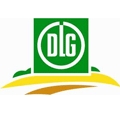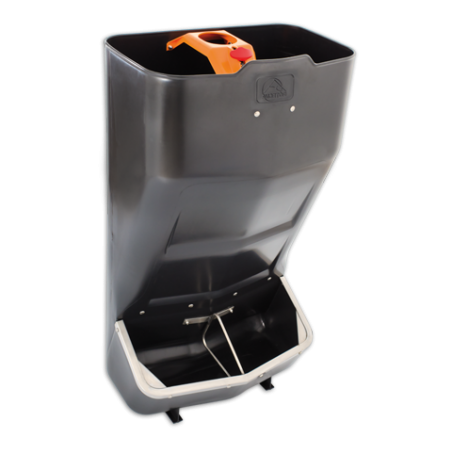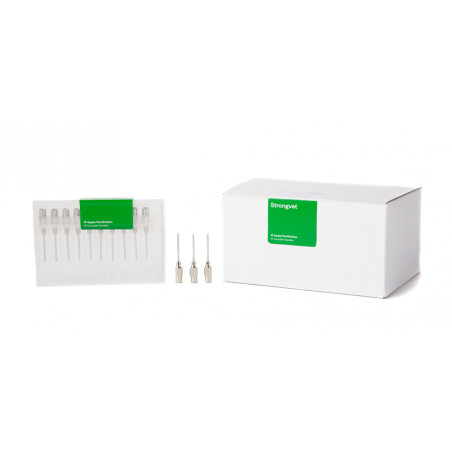
Gold award-winners
optiSCAN
Hölscher + Leuschner, Emsbüren, Germany, Hall 12, Stand F46
optiSCAN is a mobile weighing system for fattening pigs that works using 3D camera technology. The handy unit is held over the fattening pig for 3 seconds at a distance regulated by the camera itself depending on the pig body. With the 3D picture and certain coordinates it is possible to determine the weight of the fattening pig digitally.
Thanks to the optiSCAN device, the physically strenuous and time-consuming weighing of the fattening pigs is no longer necessary. optiSCAN thus improves labour management and does not cause any additional stress to the fattening pigs either. The device allows more precise, weight-related marketing and faster and more animal-kindly weighing operations. Moreover the upstream and downstream work involved in classic weighing operations, such as cleaning the driving passages and weighing platforms, is no longer required, which in turn means savings in water and disinfecting agents.
Silver award-winners
DeLaval Barn System Controller BSC
DeLaval International AB, Tumba, Schweden, Hall 27, Stand H34
BSC is an integrative and interacting system solution for holistic monitoring as well as for control and regulation of electrically powered actors in the animal housing, such as windbreak nets, fans, cooling humidifiers, manure removal and lighting. With now only one controller – accessible via the internet too – all these actors can be controlled manually or automatically not only via time cycles or time schedules, but also depending on a wide range of sensor signals such as e.g. weather and housing climate parameters, lighting intensity, motor loads, etc. Furthermore, the individual actors can be coordinated with each other for optimized process cycles, or connected with each other so that e.g. in the case of strong cross-ventilation the cooling humidifier is automatically deactivated. The essential and forward-looking further development of the BSC to a monitoring, control and regulating system for joining up previously individual systems to produce holistically optimized process cycles in a coordinated overall system makes it possible to save costs, reduce the use of energy and resources, and to facilitate labour, as well as to optimize keeping conditions for the animals.
Düsser Rooting Tower
Landwirtschaftskammer Nordrhein-Westfalen, Münster, Germany, Hall 26, Stand A05b
The Düsser Rooting Tower is a device for keeping large groups occupied, for offering variable fibrous rooting or playing materials such as e.g. straw, hay, silage. The innovative character lies on the one hand in the structural form of the Düsser Rooting Tower. Through a gap in the floor it is possible for the pigs to actively root out the enrichment material. This corresponds more to the natural rooting behaviour of the animals. A further innovation is represented by the versatile use of differently structured enrichment materials. Thus both long-fibre material and short-fibre material (chips) can be offered via the Düsser Rooting Tower. By a simple adjustment option at the device it is possible to steer the quantities selectively. This also improves possible applications in strawless operations.
The Düsser Rooting Tower is thus an innovative further development of existing occupational and enrichment equipment.
Schauer Dryfeed Holding Hopper Batch
Schauer Agrotronic GmbH, Prambachkirchen, Austria, Hall 12, Stand E35
With rope pulley and chain conveyor systems the transport pipe can only be filled approx. 50%, as otherwise the drive resistance of the installation becomes too high and as a consequence the system comes to a standstill. If the return line is not guided via the silo in order to empty residual quantities, this would result in overfilling of the line and hence excessive stress. The feed holder hopper BATCH is supplemented by a short rising auger before the feed is transferred to the conveyor line. Feed is only unloaded from the silo by the auger from the feed holder hopper when no feed comes back from the return line. The feed is then passed to the conveyor cycle via the auger again. The conveying performance of the transport auger is matched to the transport performance of the dry feeding installation. This rules out any over-filling of the system. Accordingly the line routing of the dry feeding can be executed in a simple circuit without additional deflection corners. The conveyor chain as well as all mechanical parts of the installation are thus treated gently, leading to a longer service life and accordingly bringing distinct financial and labour management advantages.
Boar Stub
WEDA Dammann & Westerkamp, Lutten, Germany, Hall 12, Stand B48
and “Ringelpietz“ Circulating Feeding System Lührs Gerätebau GmbH, Rehden, Germany, Hall 12, Stand D63
Castration of piglets without anaesthetics will no longer be possible in future for reasons of animal welfare. Consequently boar fattening will become important. In future it will have to be possible to administer different feed mixes for sows and boars in one compartment in order to exploit optimal feed conversion of the two genders housed separately.
Weda has developed a retrofit set for the control of system types M 16 and 4 PX for liquid feeding systems that work with stub lines. This makes it possible to feed different mixtures one after the other via a stub line as of a live weight of 55 kg. The prerequisite for this is gender-segregated keeping and the quantity of a complete feeding block must correspond to at least twice the content of the stub.
Lührs has developed a system for single-pipe dry feeding installations that allows different mixtures to be administered in one compartment. By installing corner drives that have been developed by the company, the chain can run both clockwise and anticlockwise. A short wait follows after feeding, before the chain is emptied by running it in the opposite direction and a new mixture is then fed to the other gender.
Both innovations can be retrofitted at low cost and satisfy today's requirements.
Sow Check oestrus detection system
Big Dutchman Pig Equipment GmbH, Vechta, Germany, Hall 11, Stand D21
The SowCheck oestrus detection system makes it possible to identify sows on heat in group keeping with a feeding station. An oestrus reflex is triggered in the sow via a number of perception levels (physical, olfactory, acoustic, optical). Sows on heat / returning to oestrus are then selected via the feeding station. The results obtained provide the user with a management aid for managing group keeping of sows optimally. In combination with the SonoCheck device, this unites oestrus detection and ultrasonic detection in a single system.
Designer Proteins
European Protein A/S, Baekke, Denmark, Hall 14, Stand F53
This is a new approach for optimizing amino acid and phosphorous supply in line with animal and performance requirements. Through the selective fermentation of different feed proteins, anti-nutritive substances are degraded and phosphorous conversion is improved. Furthermore, the remaining lactic acid bacteria have a probiotic role to play. By including various algae proteins the possible combinations are expanded considerably. With these developments not only do new prospects for nutrient supplies in line with animal requirements arise, but also distinct effects on the ecobalance of animal production result.
Farm Power Manager
Joint development: Big Dutchman International GmbH, Vechta, Germany, Hall 9, Stand C24
with Big Dutchman Pig Equipment GmbH, Hall 11 Stand D21
The Farm Power Manager software is a system for monitoring and steering the energy consumption of animal improvement farms and for tariff-dependent cost analyses and consumption predictions. Measured or nominal performance data of any electrical consumers/loads are provided by steering computers in the network to a central computer and can be analysed to find answers to various questions. Data exchange is supported on the basis of the ISO norm "ISOagriNET".
BigFarmNet Health Monitoring
Joint development: Big Dutchman Pig Equipment GmbH, Vechta, Germany, Hall 11, Stand D21
Justus-Liebig-University Giessen Institut für Tierzucht und Haustiergenetik Hall 26, Stand A16
The software tool serves to support health monitoring in group keeping of pigs with demand feeding stations. The software documents the sequence of visits and feeding times of individual sows in group keeping on one day and over relatively long periods. Assessment of the daily events is carried out with regard to the entire group. Strong deviations of individual animals indicate a health problem of the sow or return to oestrus. By means of an indication or a report concerning the respective sows, the farmer is supported in his monitoring of the animals and in farm management.

October 1, 2012 - Euro Tier 2012/ Germany





